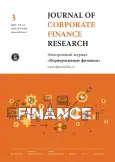The Receipt of Grants as a Key Determinant of Venture Investment Size in Russia-based IT Startups
- Авторы: Rodionov I., Semenov A., Oskin A.
- Выпуск: Том 14, № 3 (2020)
- Страницы: 19-27
- Раздел: Новые исследования
- URL: https://journal-vniispk.ru/2073-0438/article/view/303132
- DOI: https://doi.org/10.17323/j.jcfr.2073-0438.14.3.2020.19-27
- ID: 303132
Цитировать
Полный текст
Аннотация
Since 2006, Russian policymakers have been actively taking various measures to stimulate the venture capital market. Government venture capital funds are being created, for example, the Russian Venture Company with a capital of 15 billion rubles. Since 2011, thanks to the new legal mechanism, state-owned companies begin to invest in private venture funds. These measures have led to increased fundraising for startups. The main mechanism of such financing is grant support for young companies. According to 2018, the amount of grants to the total amount of funds raised in Russia is one of the highest among developed and developing countries, for comparison in the USA, it is more than 2.5 times lower. The venture market specifics is such that when deciding whether to invest in a company, investors inevitably turn their attention to the previous rounds of financing the company. The purpose of the work is to analyze the effect of the money grant received on the volumes of attracting subsequent financing.
To analyze the impact of the receiving money grant, the determinant approach was used, as the most common in research on this topic. Based on a sample of 184 Russian IT startups, two OLS models have built to show the effect of money grant size to follow-on investment rounds.
As a result, various sets of determinants were considered that explain the volume of investments attracted by startups for both international markets and the Russian market. In addition, an excursus was conducted to study the effectiveness of government venture funds, which are the main grantors in the Russian venture market. Based on the results of previous studies on this topic, it was shown that the size of the money grant has a positive effect on the amount of funding attracted in both follow-on rounds. For comparison, a number of previous studies of the Russian venture capital market show that the investment size of the current round has influenced only by the previous fundraising. Such a result testifies to the attractiveness for investors Russian IT startups that received grant support.
The scientific novelty of the article is that the amount of funding attracted by startups is explained by such a specific indicator as grant support. In addition, the results obtained have certain practical value for those who invest in Russian startups. Investing in startups that received grants increases the likelihood of an exit for the investor in the next investment round.
Об авторах
I. Rodionov
Автор, ответственный за переписку.
Email: irodiono@mail.ru
A. Semenov
Email: semenov.venture@mail.ru
A. Oskin
Email: a.a.oskin1201@gmail.com
Список литературы
- PwC & RVC. MoneyTreeTM Report. 2018. URL: https://www.pwc.ru/ru/publications/money-tree-2018.html.
- PwC & RVC. MoneyTreeTM Report. 2017. URL: https://www.pwc.ru/ru/publications/money-tree-2017.html.
- PwC & RVC. MoneyTreeTM Report. 2016. URL: https://www.pwc.ru/ru/publications/money-tree-2016.html.
- Jeng L. A., Wells P. C. The determinants of venture capital funding: Evidence across countries. Journal of Corporate Finance. 2000;6(3):241-289. doi: 10.1007/s10693-012-0146-y.
- Black B. S., Gilson R. J. Does venture capital require an active stock market? Journal of Applied Corporate Finance. 1999;11(4):36-48. doi: 10.1111/j.1745-6622.1999.tb00512.x.
- Gompers P. A., Lerner J. What drives venture capital fundraising? Washington: Brookings Papers: Microeconomics. 1998;149-192.
- Berlin M. That thing venture capitalist do. Business Review. 1998;15-27.
- Marti J., Balboa M. Determinants of private equity fundraising in Western Europe. 2001.
- Elisabete G. S. F., Cesaltina P. P., Mohamed A. G. The determinants of venture capital in Europe: Evidence across countries. Journal of Financial Services Research. 2013;44(3):259-279. doi: 10.1007/s10693-012-0146-.
- Poterba J. M. Venture capital and capital gains taxation. Tax Policy and the Economy. 1989;3:47-66. doi: 10.1086/tpe.3.20061783.
- Aylward A. Trends in capital finance in developing countries. International Finance Corporation Discussion Paper. 1998;№36. doi: 10.1596/0-8213-4303-3.
- Bonini S., Alkan S. The macro and political determinants of venture capital investments around the world. 2006. URL: http://www.efmaefm.org/0efMaMeeTIngs/efMa%20annual%20MeeTIngs/2007-vienna/papers/0576.pdf.
- Schertler A. Driving forces of venture capital investments in Europe: A dynamic panel data analysis. Kiel Working Paper. 2003;№1172.
- Rodionov I. I., Semenov A. S., Seleznev V. A. Determinants of the venture investment size in Russian IT companies. Journal of Corporate Finance Research. 2018;15:44-49.
- Colombo M. G., Cumming D. J., Vismara S. Governmental venture capital for innovative young firms. The Journal of Technology Transfer. 2016;44(1):10-24. doi: 10.1007/s10961-014-9380-9.
- Semenov A., Gosteva E. Major determinants of the volume of venture deals in the Russian IT companies. Cloud of Science. 2014;1(2):337-348.
- Semenov A., Sokolova O. Analysis of determinants of Russian private equity and VC industry based on data sample. Cloud of Science. 2015;2(2):265-281.
- Grilli L., Murtinu S. New technology-based firms in Europe: Market penetration, public venture capital and timing of investment. Industrial and Corporate Change. 2014;24(5):1109-1148. doi: 10.1093/icc/dtu025.
- Grilli L., Murtinu S. Government, venture capital and the growth of European high-tech entrepreneurial firms. Research Policy. 2014;43(9):1523-1543. doi: 10.1016/j.respol.2014.04.002.
Дополнительные файлы











